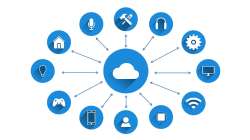Why Should You Set up Smarter IoT Devices at the Edge?
To ensure that data processing speeds can keep up with the pace of IoT growth, solution providers across the entire IoT data chain would have to innovate quickly.

Smart devices are becoming more intelligent, learning our habits and freeing us from routine jobs. Intelligent machines and the incorporation of futuristic technologies have simplified daily life. According to analyst forecasts, the IoT growth predictions for the year 2025 ranges from nearly 25 billion connected devices by GSMA to 43 billion by 2023 by IDC and about 56 billion by Mckinsey.
The ascertains that even at the low end of projections, the number of IoT devices is expected to more than double over the next several years. Furthermore, as the market matures, IoT solutions are definitely going to become more data-hungry due to the rise of video applications and the increased processing requirements of sophisticated AI and analytics technologies.
To ensure that data processing speeds can keep up with the pace of IoT growth, solution providers across the entire IoT data chain would have to innovate quickly.
Edge computing is a must-have
Edge computing is the first step in the IoT data chain, allowing data to be processed before being transmitted to application servers for further analysis. Earlier generations of IoT solutions collected data and sent it to the server in its raw, unprocessed form. While this practice is still adequate for applications such as taking a volume reading on a fuel tank once a day and alerting the end-user when the levels are getting low, it simply cannot support applications requiring higher bandwidth or lower latency.
Consider a video telematics solution for fleet operators that captures external footage in the event of an accident while also monitoring the driver's alertness. In the absence of edge computing, this solution will run into two problems: without the intelligence to recognize an accident, the device will have to transmit a large amount of (ultimately unimportant) data at a high cost, and without the ability to recognize an inattentive driver, the device will not be able to provide an immediate alert to correct the behaviour. Furthermore, such solutions may encounter situations in which data must be processed immediately. However, the cellular signal has been disrupted. This solution requires a way to minimize unnecessary data transmission, reduce latency, and process data locally in the event of a dropped signal to deliver on its value.
Enable Security at the Periphery
As IoT solutions become more prevalent in our daily lives, the network of devices available to hackers for malicious purposes expands. There has been a significant increase in the scale of these attacks in recent years. For example, the most essential distributed denial of service (DDoS) attack in 2016 brought down sites such as Twitter, Netflix, CNN, and many others. It accomplished this by gaining control of many connected video cameras, DVRs, and other devices and using them to flood the most extensive domain name system (DNS) server with traffic until it crashed.
"Our personal information and safety becomes much more vulnerable to cyber-attacks if we do not have proper security control systems in place. Cardiac devices that monitor and control patients' heart function could be hacked and controlled by malicious actors; hackers could access baby sleep monitors to spy on your child, and your car could be remotely taken over and held," said, Ranjeet Koul, Vice President and Country Manager APAC & MEA, Aeris Communications.
All of these examples highlight the critical importance of edge security. Cloud servers have robust security measures in place; data must be secured as early as possible in the IoT data chain to ensure the solution is protected from breaches. Password management, support for over-the-air firmware updates, and encryption on local Wi-Fi networks and cellular gateways are critical components of an IoT security protocol.
Don't Create a "Data Museum"
As the number of connected devices doubles over the next few years, and those devices send more data, we risk creating a "data museum," or a location where data is stored collects dust and loses value. Only analyzed information is helpful. However, suppose the back-end servers become overburdened with data from tens of billions of devices. In that case, it may become prohibitively expensive to send, process, and search that data, effectively rendering it useless. More innovative processing at the edge regulates the amount and quality of data transmitted to cloud servers, ensuring that the amount of data in the cloud does not outnumber our ability to process and analyze it.
Conclusion
More devices with intelligent edge features are expected to be used in the future of the Internet of Things. Neuromorphic or in-memory computing, spiking neural networks, and even quantum AI could be part of the AI-accelerated future. This will also make it easier to implement machine learning algorithm training at the edge. In a nutshell, IoT with an intelligent edge will pave the way for a new human-AI interface. With technology becoming more and more sustainable, it will be an exciting time for designers, engineers, businesses, and consumers.
